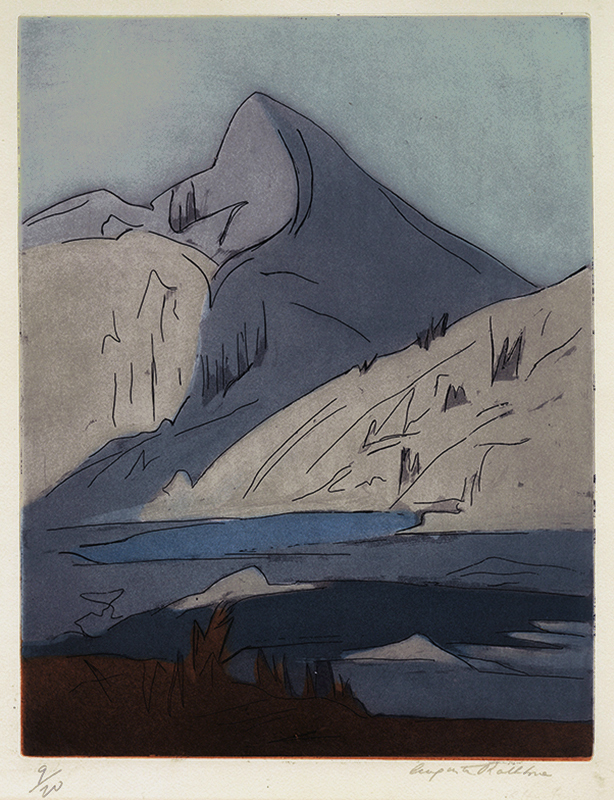
19th, 20th & 21st Century Fine Prints
707-546-7352 · fax 707-546-7924 · web: www.annexgalleries.com · email: artannex@aol.com
Desolation Valley (also called: 'Dick's Peak, Sierra Nevada) by Augusta Payne Rathbone

Desolation Valley (also called: 'Dick's Peak, Sierra Nevada)
Augusta Payne Rathbone
Desolation Valley (also called: 'Dick's Peak, Sierra Nevada)
Augusta Payne Rathbone
1897 - 1990 (biography)Dick's Peak is in the heart of Desolation Valley in the Sierra Nevada in El Dorado County, situated east of Lake Tahoe, California. It has an elevation of 9,975 feet and overlooks Dick’s Lake. It is a destination for hikers and skiers.
SummitPost notes: “The peak was named for an eccentric Englishman, Captain Richard 'Dick' Barter, also known as 'the Hermit of Emerald Bay' or the 'Hero of Robber's Roost. ' 'Captain Dick Barter was an old sailor (or shell-back, as he expressed it), who was employed by Mr. [Ben] Holladay to remain on the place and keep things ship-shape.” Captain Dick ultimately drowned in the lake while recovering from a hangover. His body was never found and the elaborate grave he had been preparing for himself was never used.
David Acton comments about this image on page 108 of his book “A Spectrum of Innovation, Color in American Printmaking, 1890-1960” (ISBN 0-393-02902-8): “’Desolation Valley’ was printed from a single plate in at least two passes through the press…Aquatint was layered on the plate in staged biting, and stop-out was not used in the areas of the etched lines; thus, the lines are surrounded by haloes of shading in the finished print. All of the colors were probably applied to the plate at once, with a brush or rag in thin washes, and then printed in the first pass through the press. The black ink intaglio and the shallow aquatint, which gives a gray cast to the image, were printed in a second pass. Registration was achieved using two pin holes through the plate, which were hidden in the etched lines…”
Augusta Payne Briggs Rathbone, painter and printmaker, was born in Berkeley, California on 30 November 1897. In 1900, her parents, Henry and Julia Briggs Rathbone, were living in the San Francisco home of her grandparents, Obil and Mary Briggs, and that same year her mother passed away. After the 1906 earthquake and conflagration, Rathbone was sent to live in Berkeley with her aunt, Edith Moses. Rathbone eventually returned to San Francisco where she attended Miss Hamlin’s School for Girls and Young Ladies. She received her BA degree from the University of California Berkeley in 1920 and the following year she sailed to Paris where she continued her studies at the Académie de la Grande Chaumière. She also studied with Lucien Simon and for several years with the Spanish artist Claudio Castelucho y Diana.
Rathbone returned to France for extended periods over the next eighteen years and her studio was located at the University Women’s Club now known as Reid Hall. Painting and sketching were her main interests until her introduction to printmaking in 1927 by the artist Nora Hamilton of Chicago. Rathbone began to concentrate on printmaking and took her plates to Monsieur Alfred Porcabeuf in Paris for printing. Her earliest intaglios featured the Sierra Nevada and urban scenes of New York and San Francisco. In the late 1930s, Rathbone created etching and aquatints of the villages in Brittany and the French Riviera. After World War II, she returned to Paris but in the face of prohibitive printing costs she purchased a small press and taught herself how to print her plates.
While in Paris in 1927, Augusta Rathbone became further acquainted with printmaking and thereafter worked primarily in color aquatint combined with line etching. Rathbone, who had studied briefly with Bonnard, uses a freely drawn black etched line to capture rough shapes which are then filled with color, using aquatint. She worked with a professional printer Alfred Porcabeuf in Paris, who would prove her prepared plates. In the 1930s she traveled the French Riviera and her color palette adapted to the colorful villages throughout the region.
